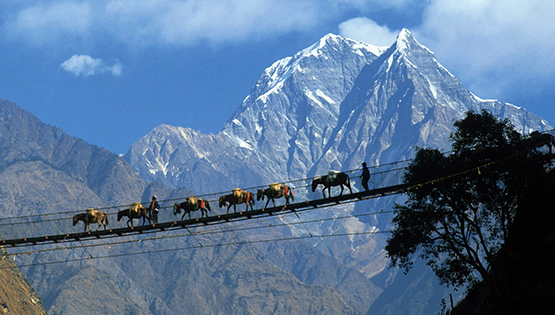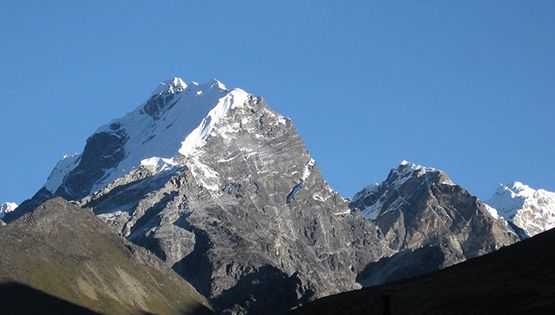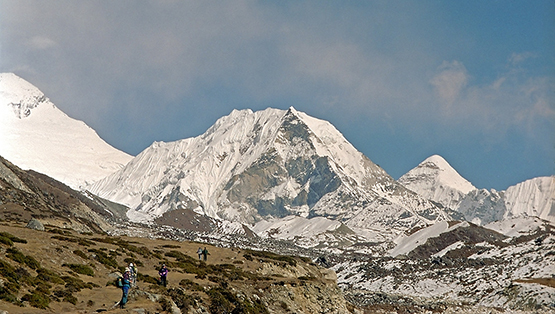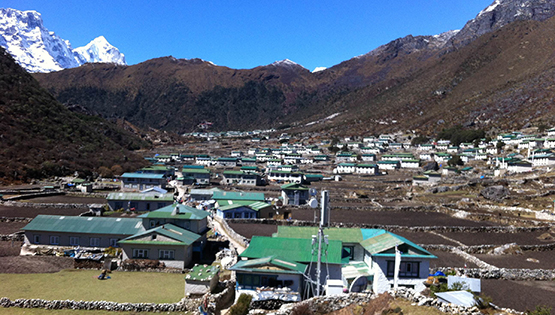Guide to Nepal
Nepal Information
____________________________________________________________________________________________
Nepal, the name itself creates a vision of beauty in the eyes of nature lover. A country though small in size but renowned for its rich biodiversity. This magical country holds sway over the imagination of every individual who once have been here or the one who wants to be here once in their life time.
Religion
Melting pot of Hinduism & Buddhism.
The two major religions practiced in Nepal are Hinduism and Buddhism with a majority of the people being Hindus. The two have co-existed through the ages and many Hindu idols are found within Buddhist shrines. Hindus visit Buddhist shrines and Buddhists visit Hindu temples without a second thought as many worship in both. Some gods and goddesses are shared by Hinduism and Buddhism although they have been given different names.
Nepal was declared a secular country by Parliament on 18th May 2006. The other religions practiced in Nepal are: Islam, Christianity, Jainism, Sikhism and Bon. Some of the earliest inhabitants like the Kirants practice their own kind of religion based on ancestor worship and the Tharus practice animism. Over the years, Hinduism and Buddhism have been influenced by these practices which have been modified to form a synthesis of newer beliefs.
Religious Festivals
Most of the festivals celebrated in Nepal have religious significance. The dates of most festivals are fixed by senior astrologers after consulting the lunar calendar. The biggest and most popular festivals are: Dashain, a celebration of Goddess Bhagabati's victory over evil Mahisashur; and Tihar, a celebration of lights dedicated to Goddess Laxmi. Other important religious festivals celebrated by various communities are: Machhendranath Jatra, Indra Jatra, Lhosar, Maghi, Chhat, Christmas, Id and many more.
Nepal has several ancient pilgrimage sites. Each temple is attached to a legend or belief that glorifies the miraculous powers of its deity. Kathmandu Valley is home to the famous PashupatinathTemple, Swoyambhunath Stupa and several other well-known temples. There are hundreds of temples in and around the Kathmandu Valley and some fabulously designed stupas.
Some well-known pilgrimage sites are: Barah Chhetra, Halesi Mahadev, Janaki Temple, Pathibhara, Tengboche in East Nepal; Manokamana in Gorkha district, Lumbini, Muktinath, Gosainkunda, Tansen, Pashupatinath, Swoyanbhunath and Boudhanath in Kathmandu Valley in Central Nepal; and Sworgadwari, Khaptad Ashram in West Nepal. Muktinath in the Annapurna region and Gosainkunda in the Langtang region are well-known pilgrimage sites that fall along popular trekking routes.
Nepal is also the gateway to Mt. Kailash, the mythical abode of Lord Shiva and the holy Mansarovar nearby. There are churches, mosques and gurudwaras located in different parts of the country.
The most prominent are the two mosques located at Durbar Marg.Pashupatinath, dedicated to Lord Shiva, is the holiest Hindu destination in Nepal. Click here for details.
Swoyambhunath is believed to have been established more than 2,500 years ago. Click here for details.
Janaki Temple dedicated to Janaki (Sita in Ramayana). Click here for details.
Nepal's History
Recorded history of Nepal is centered on the Kathmandu valley and begins with the Kirantis who are said to have ruled for many centuries beginning from the 7th or 8th Century B.C. with their famous King Yalumber who is even mentioned in the epic, ‘Mahabharata’. The Gopalas who were herdsmen are believed to have ruled before the Kirantis but little is known about them. Their descendants are said to still live at the edge of the valley. Around 300 A.D. the Lichavis arrived from northern India and overthrew the Kirantis. The descendants of the Kirantis are the Rais and Limbus who predominate in eastern Nepal. One of the legacies of the Lichavis is the fabulous Changu Narayan temple near Bhaktapur which dates back to the 5th Century. In early 7th Century, Amshuvarman, the first Thakuri king took over the throne from his father-in-law who was a Lichavi. He married off his daughter Bhrikuti to the famous Tibetan King Tsong Tsen Gampo thus establishing good relations with that country. Bhrikuti went on to convert the king to Buddhism. The Lichavis brought art and architecture to the valley but the Golden age of creativity arrived with the Mallas who came to power around 1200 A.D..
During their 550 year rule, the Mallas built an amazing number of temples and splendid palaces with picturesque squares that are lined with architecturally beautiful temples. It was also during their rule that society and the cities became well organized; religious festivals were introduced and literature, music and art were encouraged. Sadly after the death of Yaksha Malla, the valley was divided into three kingdoms: Kathmandu (Kantipur), Bhaktapur (Bhadgaon) and Patan (Lalitpur). The rivalry among these kingdoms led to the building of grand palaces and the uplifting of the arts and culture. Around this time, the Nepal as we know it today was divided into about 46 independent principalities. One among these was the kingdom of Gorkha with a Shah king in power. Much of Kathmandu valley’s history around this time was recorded by Capuchin friars who lived here on their way in and out of Tibet.
An ambitious Gorkha King named Prithvi Narayan Shah embarked on a conquering mission that led to the defeat of all the kingdoms in the valley (including Kirtipur which was an independent state) by 1769. Instead of annexing the newly acquired states to his kingdom of Gorkha, Prithvi Narayan decided to move his capital to Kathmandu establishing the Shah dynasty which ruled unified Nepal from 1769 to 2008 when the last Shah ruler, Gyanendra relinquished his power to make way for total democracy under the rule of a Prime Minister. The history of the Gorkha state goes back to 1559 when Dravya Shah established a kingdom in an area chiefly inhabited by Magars. At this time the Kathmandu valley was ruled by the Malla kings. During the 17th and early 18thcenturies, Gorkha continued a slow expansion, conquering various states while forging alliances with others. Prithvi Narayan dedicated himself at an early age to the conquest of the Kathmandu valley. Recognizing the threat of the British Raj in India, he dismissed European missionaries from the country and for more than a century, Nepal remained in isolation.
During the mid-19th century Jung Bahadur Rana became Nepal's first prime minister to wield absolute power relegating the Shah king to a mere figurehead. He started a hereditary reign of the Ranas that lasted for 104 years during which time the Shah kings had no real power. The Ranas were overthrown in a democracy movement of the early 1950s with support from an unlikely person, the monarch of Nepal, King Tribhuvan. Soon after the overthrow of the Ranas, King Tribhuvan was reinstated as the head of the state. In early 1959, Tribhuvan's son King Mahendra issued a new constitution, and the first democratic elections for a national assembly were held. The Nepali Congress Party was victorious and their leader, Bishweshwar Prasad Koirala formed a government and served as prime minister. But by 1960, King Mahendra had changed his mind and dissolved Parliament, dismissing the first democratic government.
After many years of struggle when the political parties were banned, they finally mustered enough courage to start a People's Movement in 1990. With the public rising up against absolute monarchy and demanding democracy, King Birendra accepted constitutional reforms and established a multiparty parliament with himself as head of state and a Prime Minister heading the government. In May 1991, Nepal held its first parliamentary elections. In February 1996, one of the Maoist parties went underground to wage a ruthless people's war against monarchy and the elected government. Then on 1st June 2001, a horrific tragedy wiped out the royal family along with many of their close relatives. The massacre was blamed on the Crown prince Dipendra who is said to have killed them all single-handedly and eventually shot himself in the head. With only King Birendra’s brother, Gyanendra and his family surviving, he was crowned the king. King Gyanendra tolerated the elected government for only a short while and then dismissed Parliament to grab absolute power. In April 2006, strikes and street protests in Kathmandu led to a 19-day curfew and the political parties joined forces with the Maoist rebels to bring pressure on the errant monarch. Eventually, King Gyanendra realized it was futile holding on to power and relented. He agreed to reinstate parliament. But the political parties and a majority of the general public had had enough of dynastic rule and their abuse of power. On 28th May 2008, a newly elected Constituent Assembly declared Nepal a Federal Democratic Republic, abolishing the 240 year-old monarchy. Nepal today has a President as Head of State and a Prime Minister heading the Government.
Nature
Covering an area of 147,181 sq.km, Nepal shares a border with India in the west, south and east and with the Tibetan Autonomous Region of China in the north. Kanchan Kalan in Jhapa district is the lowest point at 70m above sea level and the summit of Mt. Everest at 8,848 m is the highest. From east to west, Nepal is 800 km long and only 230 km. north to south at its widest. Within this narrow stretch of land there is incredible diversity in topography ranging from a sub-tropical climate in the tarai (plains) to Alpine conditions in the Himalayan regions. Mountains, mid hills, valleys, lakes and plains dominate the landscape of this landlocked country. Eight of the fourteen peaks over eight thousand meters lie in Nepal including Everest, the highest in the world.
Nepal also has an abundance of rivers most of which originate in the Himalaya while some flow down from Tibet. They all flow on to India, many of them joining the holy Ganges. High amid the mountains there are glacial lakes and spectacular valleys where few people venture. Recent physiographic data show that around 4.27 million hectares (29 % of total land area) is made up of forests, 1.56 million hectares (10.6%) of scrubland and degraded forest, 1.7 million hectares
(12%) of grassland, 3.0 million hectares (21%) of farmland and 1.0 million hectares (7%) of un-cultivated land.
Climatic conditions within Nepal vary from one place to another in accordance with the geographical features. In the north, summers are cool and winters severe, while in the south summers are sub-tropical and winters mild. The monsoon that brings rain from June through September affects most of the country except those that lie in the rain-shadow areas like Mustang which is within Nepal but a part of the Tibetan plateau. Large tracts of forested land have been preserved as national parks and wildlife reserves where endangered species like the Royal Bengal tiger and the Greater one-horned rhinoceros roam freely along with an amazing variety of mammals and reptiles that include bear, leopards, hyenas, wild boar, wild elephants, monitor lizards, crocodiles, pythons, turtles and various species of insects and birds. Nepal is home to almost 10 percent of the world's bird species among which 500 species are found in the Kathmandu valley alone.
The most abundant natural resource in Nepal is water. Much of the rivers have been harnessed for hydro-power but they also play a crucial role in tourism as most of them are suitable for adventure sports like kayaking and rafting.
The Himalayas are not merely a source of revenue through mountaineering and trekking, they are also mined for quartz, lignite, copper, cobalt and iron ore. The scenic beauty of the countryside attracts hordes of trekkers while there seems to be an ever increasing number of mountaineers attempting to climb the hundreds of peaks that have been opened for climbing.
UNESCO World Heritage Natural Sites
Chitwan National Park
Nepal's first and most famous national park is situated in the Chitwan Doon or the lowlands of the Inner Terai. Covering an area of 932 sq km. the park includes hilly areas of the Siwalik Range covered by deciduous sal forest. One fifth of the park is made up of the floodplains of the Narayani, Rapti, and the Reu Rivers and is covered by dense tall elephant grass interspersed with riverine forests of silk cotton (kapok), acacia and sisam trees. This ecologically diverse area is the last remaining home in Nepal for more than 300 of the endangered Asian one-horned rhinoceros and harbours one of the largest populations of the elusive and rare Bengal tiger. Besides rhino and tiger, Chitwan also supports a great variety of flora and fauna. There are four species of deer, including the spotted chittal, leopard, sloth bear, wild boar, rhesus monkey, grey langur monkey, wild dog, small wild cats, the white stockinged gaur (the world's largest wild cattle) and many other smaller animals. The swampy areas and numerous oxbow lakes of Chitwan provide a home for marsh crocodiles. In a stretch of the Narayani river is found one of the few remaining populations of the rare and endangered fish-only eating gharial, or Gangetic crocodile. Here also is found one of the world's four species of freshwater dolphins. For the ornithologist and the amateur bird-watcher the park offers excellent possibilities with more than 450 species recorded. Some of the resident specialities are several species of woodpeckers, hornbills, Bengal florican, and red-headed trogons. Winter birds such as waterfowl, Brahminy duck, pintails and bareheaded geese, amongst many other cold weather visitors are drawn by the sanctuary of the park's rivers. In the summer the forest is alive with nesting migrants such as the fabulous paradise flycatcher, the Indian pitta and parakeets.
Sagarmatha National Park ( Mt. Everest )
Unique among natural heritage sites world-wide is the Sagarmatha National Park, which includes Mt. Everest (8,848 m) and other high peaks such as Lhotse Shar, Cho Oyu, Ama Dablam, Pumori, Kangtega, Gyachung Kang, Thamserku and Kwangde. Located North-east of Kathmandu, Sagarmatha National Park is 1,148 sq km. in area and consists of the upper catchment areas of the Dudh Koshi, Bhote Koshi and the Imja Khola rivers. Much of the park lies above 3,000m. Sagarmatha is rugged, with deep gorges, glaciers and unnegotiable ice and rock faces. Locally known as the 'Khumbu', it is the home of the famous Sherpa people. The Sherpas make a living by farming barley and potatoes and graze their yaks in high altitude pastures. Young Sherpas have also made their name in mountaineering and the trekking industry has of late become the community's economic mainstay. In 1979 the park was declared a World Heritage Site.
Trees such as rhododendron, birch, blue pine, juniper and silver fir are found up to an altitude of 4,000 meters above which they give way to scrub and alpine plants. In late spring and summer, the hillsides around the villages of Namche Bazaar, Khumjung, Thyangboche and Thame are a riot of colours with several species of rhododendon in bloom. Wildlife most likely to be seen in Sagarmatha are the Himalaya tahr, ghoral, musk deer, pikka (mouse hare) weasel and occasionally jackal. Other rarely seen animals are Himalayan black bear, wolf, lynx and snow leopard. Birds commonly seen are Impeyan pheasant, blood pheasant, snow cock, snow pigeon, red billed and yellow billed chough, Himalayan griffin vulture and lammergeier.
Nepal security assessment
The world is a mess, Nepal is also. However, in summary: so far it has always safe to trek and travel in Nepal, there may be strikes, delays and inconveniences—there may not—BUT you have never been a target. You are safe from orchestrated political violence, even Americans, so come have an adventure.


















